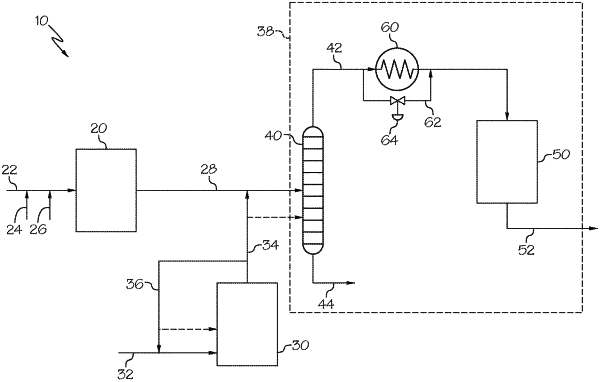| CPC C07C 7/167 (2013.01) [B01D 3/14 (2013.01); B01D 45/16 (2013.01); B01J 23/62 (2013.01); C07C 4/04 (2013.01); C07C 5/3337 (2013.01); C07C 7/005 (2013.01); C07C 7/04 (2013.01); C07C 2523/62 (2013.01)] | 15 Claims |

|
1. A method for operating an acetylene hydrogenation unit of an integrated system for producing olefins, the method comprising:
separating a first process effluent from a first olefin production process into at least a hydrogenation feed and an acetylene-depleted stream in a separation system, the hydrogenation feed comprising at least acetylene, carbon monoxide, and hydrogen;
one or both of:
introducing at least a portion of a second process effluent from a second olefin production process to the separation system; or
combining the at least a portion of the second process effluent with the first process effluent upstream of the separation system;
wherein introducing the portion of the second process effluent to the separation system, combining the portion of the second process effluent with the first process effluent, or both, increases a concentration of carbon monoxide in the hydrogenation feed;
contacting the hydrogenation feed with an acetylene hydrogenation catalyst in the acetylene hydrogenation unit, the contacting causing hydrogenation of at least a portion of the acetylene in the hydrogenation feed to produce a hydrogenated effluent, wherein:
an elevated concentration of carbon monoxide in the hydrogenation feed reduces a reaction rate of the hydrogenation of the acetylene, wherein the reduction in the reaction rate is independent of temperature;
the elevated concentration of carbon monoxide in the hydrogenation feed is due to the portion of the second process effluent; and
the acetylene hydrogenation unit operates at an elevated temperature relative to normal operating temperatures, wherein normal operating temperatures occur when the portion of the second effluent is not introduced to the separation system, combined with the first process effluent, or both, and wherein a concentration of acetylene in the hydrogenated effluent is less than a threshold acetylene concentration.
|